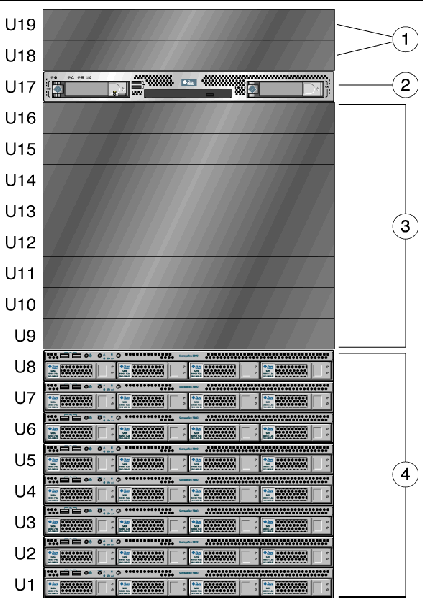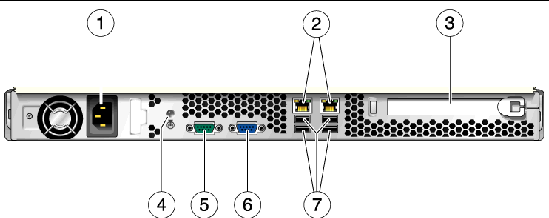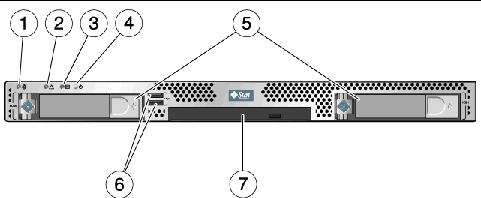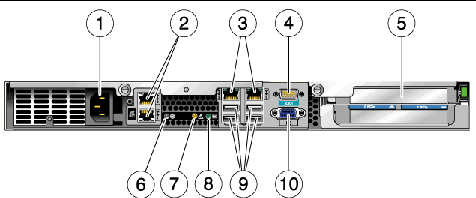| C H A P T E R 1 |
|
Product Overview |
This chapter provides an overview of the Sun StorageTek 5800 System. It includes the following sections:
5800 System. It includes the following sections:
The 5800 system is a self-contained storage unit that attaches directly to a network. It does not use typical data and file structures: there are no pools, volumes, logical unit numbers (LUNs), or redundant arrays of independent disks (RAID) to set up or manage.
Instead, the 5800 system uses an object-oriented methodology to store fixed-content data files (files that will never be modified) as if they were individual objects. The storage system assigns each of these data objects a unique identifier called an Object ID (OID) based on the attributes of the data object. Applications use the OIDs to query and retrieve the data objects.
The 5800 system employs a cluster of storage nodes. Each storage node is an individual server with CPU processing power, RAM, and four Serial Advanced Technology Attachment (Serial ATA) disk drives for storage. Each storage node has hardware and software that is identical to that of the other storage nodes, but each storage node operates independently. This configuration allows for all storage processing and data path operations to be distributed across the available processing power of the system and enhances both system reliability and performance.
Each 5800 system includes a single service node with preconfigured software and firmware. The system uses the service node for initial configuration, for troubleshooting, and to upgrade the system software.
The basic 5800 system is a full-cell configuration that includes 16 storage nodes, 1 service node, 2 gigabit Ethernet switches, a network patch panel, and preinstalled operating system and software. A half-cell configuration, which includes only 8 storage nodes, is also allowed. You can expand (scale) a half-cell configuration to a full-cell configuration. You can also expand a full-cell configuration to create multicell configurations, also referred to as hives. Only full-cells are allowed in multicell configurations.
Features of the 5800 system include:
The 5800 system ships from the factory fully installed in a rack and with the software loaded in the default configuration.
This section includes the following topics:
The full-cell is the basic building block of the 5800 system. A full-cell includes a service node, 16 storage nodes, 2 gigabit Ethernet switches, and a network patch panel. The front view of a single full-cell is shown in FIGURE 1-1. Additional full-cells in a multicell system (referred to as a hive) are identical.
FIGURE 1-1 5800 System Full-Cell Front View

|
Filler panels hiding two rear-facing gigabit Ethernet switches and a rear-facing network patch panel located behind the lower switch |
|
The gigabit Ethernet switches are installed with their ports facing towards the back of the cabinet. Filler panels are installed in the front of the cabinet at the same elevation as the two switches. The network patch panel is mounted behind the lower switch on the back of the cabinet (see FIGURE 1-2). Both of the gigabit Ethernet switches are connected to the service node, to all the storage nodes, and to the network patch panel.
Storage node number 101 is on the bottom of the cell; the numbering of the storage nodes gets higher as you go up the cell, with node 102 above node 101, followed by node 103 above that and so on.
FIGURE 1-2 Rear View of a Two-Cell System, Showing Network Patch Panel Connections

If you chose to populate the cabinet with only a half-cell (eight storage nodes), slots U9 through U16 have filler panels on the front, as shown in FIGURE 1-3. A half-cell configuration is stand-alone and cannot be combined with another full-cell. To add another full-cell to the hive, you must first add additional storage nodes to expand the half-cell to a full-cell configuration. Because a half-cell has a reduced number of storage nodes, it does not have the same inherent reliability as that of a full-cell with 16 storage nodes.
FIGURE 1-3 5800 System Half-Cell Front View

|
Filler panels hiding two rear-facing gigabit Ethernet switches and a rear-facing network patch panel located behind the lower switch |
|
Three configurations of the 5800 system can be housed in a single cabinet:
Systems having more than two full-cells must be accommodated with additional cabinets.
The key features of the 5800 system storage node are listed in TABLE 1-1.
|
Intelligent Platform Management Interface (IPMI) 1.5-compliant service processor module |
FIGURE 1-4 shows the front panel components of a 5800 system storage node. Pressing the locator switch on the front of the storage node causes the Locator LEDs on both the front and the back of the node to blink so that you can easily identify a particular node from the front and back of the cabinet. TABLE 1-2 explains the functions and characteristics of the storage node switches and LEDs.
FIGURE 1-4 Storage Node Front Panel Components

FIGURE 1-5 shows the back panel components of a 5800 system storage node.
FIGURE 1-5 Storage Node Back Panel Components

The service node is a Sun Microsystems Sun Fire X2100 M2 server with one 250-gigabyte Serial ATA disk drive. The 5800 system uses the service node for initial configuration and troubleshooting, and to upgrade the system software. The system does not use the service node to access the data objects. The key components of a service node are listed in TABLE 1-3.
X2100 M2 server with one 250-gigabyte Serial ATA disk drive. The 5800 system uses the service node for initial configuration and troubleshooting, and to upgrade the system software. The system does not use the service node to access the data objects. The key components of a service node are listed in TABLE 1-3.
|
Four 10/100/1000BASE-T GB Ethernet ports, two Broadcom and two NVidia. (The 5800 system uses the two Broadcom ports.) |
|
FIGURE 1-6 shows the front panel of the service node.
FIGURE 1-6 Service Node Front Panel Components

|
Hard disk drive bays. The single disk drive is located behind the left drive bay latch. |
|||
FIGURE 1-7 shows the back panel of the service node.
FIGURE 1-7 Service Node Back Panel Components

A half- or full-cell 5800 system includes two gigabit Ethernet switches. The switches allow the system to be addressable from a single physical Ethernet connection (with a redundant backup) as two virtual IP (VIP) addresses: one for data and one for administration. The switches also enable load-balancing capabilities for store and retrieve data flows to and from the storage nodes by making use of chipsets that support basic packet header analysis of hash-table based routing information.
FIGURE 1-8 shows the components of the switches. One of the switches is designated as primary and the other as standby. By default, the bottom switch is the active, primary switch, and the top switch is the secondary switch in standby mode. If the primary switch fails, the secondary switch takes control automatically and becomes the primary switch. If the primary switch comes back online, it resumes control.
Storage nodes 1 through 16 are connected to Ethernet ports 1 through 16 of each switch. The service node is connected to port 17 of each switch. The switches are connected to each other for heartbeat communication by ports 23 and 24 of each switch. See TABLE 1-4 for an explanation of how the primary and secondary switches are connected to the network patch panel.
FIGURE 1-8 Gigabit Ethernet Switch

A single network patch panel on the back of the 5800 system provides all the attachment points for the network. FIGURE 1-9 shows the port configuration of the network patch panel.
FIGURE 1-9 Network Patch Panel

The Ethernet ports are designated SxUy, where:
S = Switch x = Switch number U = Uplink y = Port number
S1 is the primary switch and S2 is the secondary. The secondary switch becomes operational when the primary fails. The S1U2 and S2U2 connections are for Sun service personnel only.
This section describes the 5800 system software. It includes the following topics:
You manage and upgrade the 5800 system software as a combined bundle rather than as individual components. The software components of the bundle include:
Even though there are many components, each with their own unique software, BIOS, and firmware, they are upgraded as a whole unit. Even if only one component needs upgrading, the version number of the bundle changes, and you must upgrade the entire bundle.
Metadata is information that describes a data object. The 5800 system stores metadata about all data objects in a distributed database. Users can issue queries to search the database and find objects based on the metadata assigned to them. The 5800 system allows two types of metadata: system and extended.
The 5800 system automatically assigns system metadata to every data object when it is stored on the 5800 system. System metadata includes a unique identifier for each object, called the Object ID or OID. The application programming interface (API) included with the 5800 system can retrieve the object using this OID. System metadata also includes creation time, data length, and data hash.
Extended metadata goes beyond the system metadata to further describe each data object. For example, if the data stored on the 5800 system includes medical records, extended metadata attributes might include patient name, date of visit, doctor name, medical record number, and insurance company. Users can issue queries to retrieve data objects using these attributes. For example, a query could retrieve all records (data objects) for a given doctor and a particular insurance company.
The 5800 system stores data objects across multiple storage nodes and disks using 5+2 encoding. The system can tolerate up to two missing data or parity fragments. After a failure of a disk or a storage node, the system distributes the data and/or parity to other storage nodes and disks. After a rebuild cycle, the system can tolerate another two missing data or parity fragments.
When a data object comes into the system, the gigabit Ethernet switch directs the store request to a storage node, and that node fragments the object and distributes the fragments to different disks in the system. The 5800 system breaks up the data into data and parity chunks. A placement algorithm then decides out of thousands of different layout possibilities where to put the chunks.
The 5800 system exports two virtual IP (VIP) addresses: one for data processing and one for administrative functions. Your interaction with the system does not require a knowledge of the underlying hardware. Instead, you access it as a single large system.
The 5800 system provides a number of different user interfaces for data processing and management functions, as shown in TABLE 1-5.
A Java and C language-based application program interface (API) provides the basic store and retrieve commands with additional query semantics.
and C language-based application program interface (API) provides the basic store and retrieve commands with additional query semantics.
You perform data processing tasks on the 5800 system using the API or WebDAV, both of which are available through the data VIP address.
The Java and C language APIs enable you to store, retrieve, query, and delete data and metadata through Java and C client libraries. Sample applications and command-line routines that demonstrate the 5800 system’s capabilities as well as provide good programming examples are provided in the client software developer’s kit (SDK).
The SDK also provides an emulator that can run on the Sun Solaris, Red Hat Enterprise Linux, and Microsoft Windows operating systems. The emulator imitates the behavior of a 5800 system, allowing you to test your software or applications. For more information on the SDK, see the Sun StorageTek 5800 System SDK Developer’s Guide. For more information on the Java and C client APIs, see the Sun StorageTek 5800 System Client API Reference Guide.
The Web-based Distributed Authoring and Versioning (WebDAV) protocol is a set of extensions to the HTTP/1.1 protocol that allows you to read, add, and delete files on remote web servers. You can set up virtual file system views in the 5800 system that allow you to use WebDAV to browse through data files on the system as though they were stored in a hierarchical path structure.
For example, you could set up a virtual file system view that included medical records as a folder, and included subfolders for a number of different doctors or hospitals. You could then use a web browser to view those files and add and delete new files to the folder and subfolders.
WebDAV is not supported for multi-cell configurations.
You perform administrative tasks using either the command-line interface (CLI) or the graphical-user interface (GUI). The remainder of this guide details the administrative tasks that are available and the CLI and GUI procedures to perform each task. For additional information on the GUI, refer to the online Help supplied with the software.